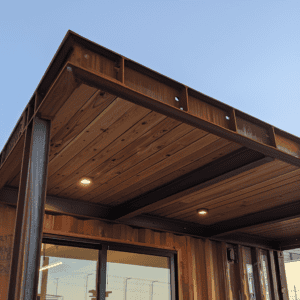So, you’ve got a shipping container and some timber, but you’re not sure how to marry the two. Don’t fret! We’re here to guide you through this simple process.
In this step-by-step guide, you’ll learn how to secure timber to a shipping container, transforming it into a cozy space or a useful storage unit. It’s easier than you’d think, and before you know it, you’ll be showing off your handy work to all your friends.
The Benefits
When you fix timber to a shipping container, you’re not just enhancing its aesthetic appeal, but you’re also boosting its structural integrity.
Fixing timber battens to the container walls, at specific timber fixing points, can provide critical insulation. This process involves attaching timber and sheet materials to the container, thereby adding a layer of insulation. This insulation is essential in maintaining a hot or cold climate within the container.
Apart from insulation, timber cladding also serves as a protective layer against weather elements.
Understanding how to fix timber to a shipping container can significantly enhance its usability and longevity.

Why Would I Need to Fix Wood to a Shipping Container
While you might wonder why you’d need to fix wood to a shipping container, it’s important to realize that it’s not just about aesthetics, but also about enhancing the container’s functionality and lifespan.
Shipping containers often face harsh weather conditions, and attaching wood, particularly to the shipping container roof, can provide additional insulation and protection from the elements. It can also give your container a more homely feel.
Fixing timber to a container isn’t overly difficult, requiring a few basic woodworking tools. You’ll need screws or bolts to secure the wood. Remember, it’s important to do this properly to ensure the timber is firmly attached, extending the life of your shipping container and making it a more useful space.
Plywood Bolt On Adapter for Timber
You’ll find that a plywood bolt-on adapter is a handy tool for securely attaching timber to your shipping container. This device allows you to screw sheet material directly to your container walls with ease. It’s particularly useful when it comes to shipping container cladding – a process where you clad the container’s exterior with timber battens for added durability and aesthetics.
Using a plywood bolt on adapter for timber, you can easily fix your timber to a shipping container. The domino clamp is an excellent companion to the plywood bolt, facilitating the attaching process. This combination ensures a sturdy and secure fit, providing a sound structure for the walls of your shipping container. This way, your container isn’t only robust but also appealing.
What You’ll Need
Often, you’ll need a couple of essentials to properly attach the timber to your shipping container. Your method will determine the specific tools, but generally, you’ll require domino clamps, screws, and a drill.
Domino clamps are particularly useful for this project as they grip onto the shipping container’s corner casting, providing a secure base to fix the timber.
Next, you’ll need screws. The type and size of the screws depend on the thickness of the timber you’ll be fixing to the container.
Lastly, you’ll need a drill to drive the screws into the timber and container. This process is an essential part of the build, ensuring the timber is securely fixed. With these tools, your project becomes a straightforward process.
How to Attach Timber to a Shipping Container
To start attaching timber to your shipping container, first secure the domino clamps to the container’s corner casting. This serves as the primary support for the timber frame.
Next, align your timber with the clamps. Ensure it’s level before drilling it into place. Now, you’re ready to fix the timber to the clamps. This process is similar to most metalworking guides, just with structural extras.
Once the timber is securely attached, you can add additional support if needed. Remember, the strength of your frame depends on how well the timber is fixed to the shipping container. So, take your time and do it right. With patience and precision, you’ll have a solid, secure timber frame on your shipping container.

How to Put It Together
Now that you’ve securely fixed the timber to your shipping container, it’s time to look at how we put it all together. Start by applying a strong adhesive, like industrial-grade glue, to the timber. This helps it bond more effectively with the steel surface of the shipping container.
When you’ve glued the timber, attach it to the exterior wall of the container. Make sure it’s firmly in place. This forms the basic structure of your building. The timber serves as a robust yet flexible material, providing extra support and insulation to the steel structure.
Frequently Asked Questions
How do you fix timber cladding to a shipping container?
Fixing timber cladding to a shipping container typically involves a few key steps to ensure a secure and aesthetically pleasing finish. Most online tutorials, including guidance from Domino Clamps, suggest initially welding strong angle brackets to the container’s exterior. These brackets serve as a foundation for attaching timber battens, which are crucial for creating the frame and structure for the cladding.
Alternatively, some methods recommend gluing timber battens directly to the container walls. This approach provides a base on which the timber cladding can be fixed, either vertically or horizontally, depending on the desired aesthetic and structural requirements. The choice between welding and gluing depends on the specific needs of the project, including considerations for durability, the weight of the timber, and the overall design vision.
Can I screw into a shipping container?
Yes, you can screw into a shipping container, but it requires specific considerations due to the container’s steel construction. For attaching items to the inside or outside of a shipping container, fine machine screws with threads such as 10-32, 1/4-28, and M6-1.0 are suitable. These screws can effectively engage with the container’s steel walls, provided that the surface is flat and smooth.
However, due to the rough surface of most containers, care must be taken to ensure a secure fit. It’s also recommended to seal the screw points with silicone to prevent leaks and maintain the container’s integrity. Especially if you want to make sure the container is as waterproof as it gets. This method allows for the attachment of various items to a shipping container without compromising its structure.
What types of timber are best for cladding a shipping container?
When it comes to cladding a shipping container, timber is a popular choice due to its aesthetic appeal and natural insulation properties. The most recommended type of timber for this purpose is white spruce, known for its durability and longevity, especially when tanalised to enhance its resistance to the elements.
This makes it a budget-friendly yet effective option for cladding. Timber cladding not only adds warmth and a natural look to a shipping container but also offers a range of finishes and styles to suit different preferences and budgets. Whether aiming for a rustic or modern appearance, timber cladding can significantly enhance the curb appeal of a shipping container, making it blend seamlessly with its surroundings or stand out as a statement piece.
How do I ensure the timber attachment is weatherproof?
Ensuring the timber attachment is weatherproof involves several key steps to protect the wood from moisture, UV rays, and other environmental factors. To start, applying a waterproof sealant or outdoor wood stain is crucial. This treatment helps to shield the timber from moisture and prevents UV damage, extending its lifespan and maintaining its appearance. There are ways to protect your entire storage container from moisture, too.
For optimal protection, it’s recommended to sand down the wood surface before applying the sealant, as this ensures better adhesion and a smoother finish. Additionally, reapplying the sealant or stain periodically can maintain the wood’s weather resistance over time. For areas exposed to high humidity or direct water contact, using a UV-resistant sealant can offer extra protection against sun damage. Regular shipping container maintenance, including inspections and touch-ups, can further ensure the timber attachment remains weatherproof and durable.
Conclusion
Fixing timber to a shipping container is not as daunting as it might initially appear. You’ve learned how timber and sheet materials can be fixed to the metal structure of a shipping container to create extra storage or to insulate against temperature extremes.
You’ve learned to leave air gaps to prevent condensation and to fix the wood securely to the container roof and walls. This combination of wood and metal can create a robust, functional space. Shipping containers and timber may seem like unlikely partners, but as you’ve discovered, they can be combined effectively and efficiently.
The process is straightforward, and the result is a shipping container that’s more useful than ever before.


